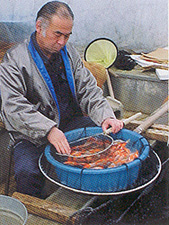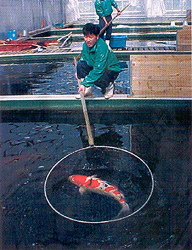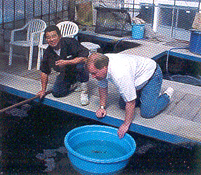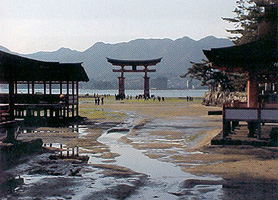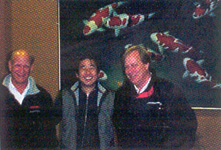"The Koi of Hiroshima" Preface At the March meeting of the Washington Koi and WaterGarden Society, Mr. Joel Burkard of Pan Intercorp showed a video of the Sakai Fish Farms of Hiroshima. As we left the meeting, we remarked how great the video was and how it would be great to see our friends again. Joel said, "How about next weekend?" I jokingly replied, "I can't this weekend. How about next week?" That was the start. One week later, to the day, Joel and I were winging our way across the Pacific to Japan. On the plane, I still couldn't believe I was making this trip. Sakai For many in the Koi keeping hobby, Niigata Prefecture in northern Japan, is the ultimate Koi experience. The Fall harvest in Niigata is something that most "Koi Kichi" (koi crazy) hobbyists would enjoy. The pace is grueling. The object is to visit as many Koi breeders as possible and see every one of the millions of fish that have just been brought in from the summer grow ponds. If possible, an invitation to help participate in a pond draining is a real gift. You are the first person to see and hold fish the haven't been seen in months! Is there a Koi Kichi experience to compare with this? You bet! Hiroshima Prefecture in southern Japan is the host to many top Koi breeders and home of the Sakai Fish Farms. Sakai is the largest Koi breeder in Japan. The shear numbers of Koi at one facility is mind boggling. They also happen to be the breeder of the Grand Champion in the All Japan Shinkokai and All Japan ZNA shows. If you want to buy a fish to compete at that level, Sakai Farms is the place to go. Among the new generation of Koi breeders is Kentaro Sakai, son of Hiroji Sakai, and nephew of Yoshimichi Sakai, the brothers who own and manage Sakai Fish Farms. Kentaro Sakai represents the fourth generation of Sakai Fish Farms. He spent some time in America learning about our market and import/export at Pan Intercorp where we became freinds. Ken, as club members knew him, helped at several of the Washington Koi and Water Garden Society's Koi shows as a fish handler. Now he is judging Koi shows. It has been a pleasure to watch how he has grown into this role over the years.
Although Sakai fish are available from many dealers and brokers in Japan, you can't go to Sakai Farms and buy a fish. They don't do retail sales and their facility is not set up to handle small orders or lots of visitors. Joel Burkard and I were in the enviable posistion of personal guests and therefore were privileged to see the grounds and facilities. You can drive several miles to visit different grow ponds that are part of Sakai Fish Farms. On the visit we got to see some of the newest facilities, covering acres, that are landscaped like beautiful parks. Complete with gazebos and bar-be-ques. On previous trips I have always gone in the fall to see the fish fresh out of the grow ponds. On this trip, in the spring, I got to see some of the preparation that goes into getting ready for the coming summer. The final culling, preparing the mud ponds, choosing breeders for the coming season, and even purchasing fish to add new blood to certain breeds. At Sakai Farms, every part of the process is planned and put on paper; nothing is left to chance. One example of this is the attention to detail as they groom and cultivate their fish. On a visit to the farm a couple of years ago, I was shown which fish they had selected to be competitors for the All Japan Koi Show for the next several years. They were right! On this trip I was shown more fantastic fish that were being groomed for upcoming shows. If asked, Sakai can show logs of the growth and photos of every high quality fish since it was a yearling. The record keeping is beyond comprehensions and not one bit is on a computer. Every fish of note is committed to memory. To borrow a term from the stock market, there are rule makers and rule breakers. At Sakai Farms, it is much the same. The competitive level fish are chosen for their over-all qualities, not individual imperfections. The All Japan Grand Champion was a Sanke that had a black spot on the head. If you went by the book, you might have turned this fish down! I was shown another Sanke at Sakai who had lots of black in the red areas of the fish. It was Yoshimichi Sakai who showed me, upon closer examination, that each of the black areas was outlined with a ring of single white scales. To the average hobbyist, including myself, this fish would have been deemed nothing special, to the sharp eyes of the Sakai team this fish has fantastic potential. The thrill of visiting Sakai Fish Farms is the immense number of fish to choose from and the high quality of those fish. It is possible to see ponds full of fish, any one of which would take Grand Champion at most American shows. Omosako Fish Farms Our next stop on this trip is to Omosako Fish Farms to discover Shiro Utsuri. Imagine an entire fish farm of nothing but black and white fish. You open up the door to Omosako San's office and you can see his judge's ribbon from the Washington Koi and Watergarden Society's Koi show prominently displayed on the wall next to pictures of his original Shiro Utsuri. YOu open the door to one of his greenhouses and across the pond swims a wave of black and white fish toward you. This man is truly Mr. Shiro Utsuri. As you look at all of the Utsuri calsses in the All Japan Show, you can see an Omosako fish somewhere in the top three places in almost every size. In Japanese Utsuri means reflections. The sumi (black) pattern is often mirrored on the other side of the fish. In textbook cases this gives the impression of a checkerboard. In a Shiro Utsuri, the opposite color is white. In Omosako's top fish, the white is brilliant like fresh snow. It creates a striking contrast to the black. Black in every shade from laquer-like jet black to the phantom or shadowed black called Kage (ca-gay). Appreciating these fish takes me back to my days of black and white photography or the striking Japanese art form of Sumi painting. You can have the power of fish with more black or the ethereal elegance of a fish with more white, or anything in between.
Omosako himself is very charming and so is his family. He has two sons: one is doing an internship with another Japanese breeder and the other is doing an internship with Pan Intercorp in the United States. His daughter, Eri, is a cute little girl who has discovered boys, and the internet. Some thing are universal. Mr. Omosako showed us his entire farm located in the hills above the coast, and we spent most of the day talking fish. The large "show room" consists of one giant pond and several smaller ponds all stocked with larger fish and tategoi. The other green houses are interconnected and contain the bulk of the younger stock. The farm has several grow ponds surrounding it. Every pond is full of black and white fish, with an occasional Showa dotting the ponds to add a drop of color. Later in the day, Mr. Omosako took us around to see some of the other breeders and sites of Hiroshima Prefecture. (A Prefecture is about the equivalent to an American State.) Koi hopping in Hiroshima is a long distance process-there is about on hour and a half between major breeders. More to see Mr. Omosako did us a personal favor and showed us some of the sites in the Hiroshima area, including Miyajima Island. Miyajima is one of the to three "must see" sites of Japan. It features shrines first built in the latter half of the sixth century. Other structures on the island date from the 12th and 16th centuries. It was a fantastic experience that I will never forget. The day was topped off with an evening visit to Konishi Koi in Hiroshima City. They knew we were coming and had stayed late for us. Now here was a Koi dealership that would knock your socks off. An ample supply of quite beautiful and healthy Koi to see and a facility that resembles a Nordstrom of the Koi world, with oil paintings of Koi on the wall, staircase to an open viewing balcony on the second floor, and much much more. By the time we returned to the hotel, my visual sense had well exceeded overload-too many beautiful sights in one day. I was beat.
On our final morning we got up early and headed off to a regional ZNA Koi Show. It was a fun time and there were plenty of fish to look at. Sadly we had to leave before the show was over and had to bid goodbye to Mr. Omosako as we caught the train for the airport. I hope you enjoyed this small taste of the Hiroshima area and some of its world famous Koi breeders. We are already planning a trip for the fall so I will share that trip with you next winter. Keep Koi Kichi!
BACK TO TOP |
|||||||||||||||||||
|
|
|||||||||||||||||||

